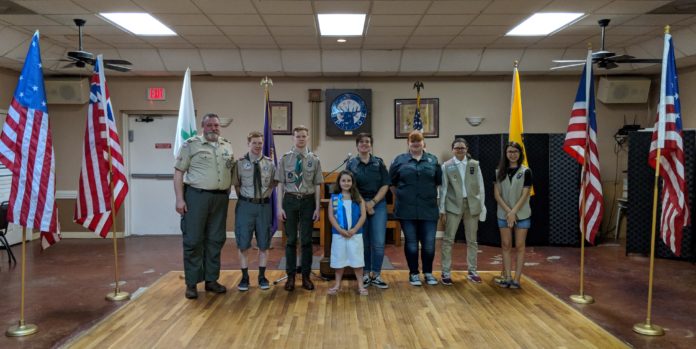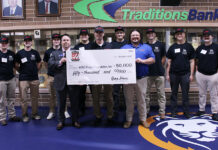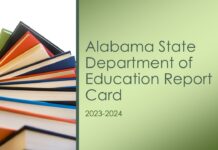
CULLMAN, Ala. – Devoted to God, country and fellow man, members of the Benevolent and Protective Order of Elks (more commonly known as the Elks Lodge) strive to embody the ideas of charity, justice, fidelity and brotherly love – all while practicing fierce and devout patriotism. The Cullman Elks (Lodge #1609) are no exception to this, and their celebration of Flag Day displayed their dedication to these ideals loud and clear this week.
Dale Ball, exalted ruler of the Lodge, gave a short welcome to the guests to kick off the ceremony, which was followed by a singing of the national anthem and am invocation delivered by Lodge Chaplain Adam Richards. Afterward, Eagle Scouts from Boy Scout Troop 219, Girl Scouts from Troop 39 and Adventure Crew Scouts helped present previous versions of the American flag, while Esquire Officer Charley Craven gave a history of each flag as it was presented.
Flag #1 (1775): A green pine tree on a white background. This flag was carried by Continental forces at the Battle of Bunker Hill.
Flag #2 (1776-1777): A coiled snake on a yellow background with the words “Don’t tread on me.” Used by the southern colonies during the years listed.
Flag #3 (latter part of 1775): Thirteen stripes of alternating red and white, with a blue field in the corner bearing both the red cross of St. George and the white cross of St. Andrew. Created by a special committee appointed by the Continental Congress. Was hoisted to the masthead of the flagship /Alfred/ in December 1775, and flown over General Washington’s headquarters in Massachusetts one month later.
Flag #4 (June 14, 1777): Thirteen stripes of alternating red and white, with a blue field in the corner bearing a circle of thirteen white stars (also known as the Continental Colors or the Grand Union). Was never carried in the field by Continental land forces, but was carried exclusively by the Navy. Was the first American flag to receive a salute of honor.
Flag #5 (1776): Fifteen stripes of alternating red and white, with a blue field in the corner bearing fifteen white stars in straight rows. Believed to have been commissioned by George Washington to Betsy Ross, who suggested that the stars have five points instead of six. Was first flown at Ft. Stanwix (known at the time as Ft. Schuyler) on Aug. 3, 1776, and was under fire three days later at the Battle of Oriskany. The first official salute to the Stars and Stripes was given by the French and took place on February 14, 1778. The flash being saluted had been made by young ladies in Portsmouth, NH, from strips of their best silk dresses and a white wedding gown from a recent bride. The two additional stars and stripes were added in 1795 to represent Kentucky and Vermont. The War of 1812 was fought under this version of the banner, and the sight of it flying inspired Francis Scott Key to write what would become the national anthem. Margaret Young, who cut the stars for that particular banner, was the mother of Henry Sanderson, who would become the Grand Exalted Ruler of the Order of Elks in 1884.
Flag #6 (July 4, 1818): Thirteen stripes of alternating red and white, with a blue field in the corner bearing twenty white stars in straight rows. On April 14, 1818, Congress adopted a resolution declaring that on or after July 4, 1818, all flags would have thirteen stripes and a blue field in the corner with one star for each of the twenty states, and a new star would be added for each state admitted thereafter.
Flag #7 (1912 – 1959): The design specified by Congress previously, bearing 48 stars. This version flew for 47 years, and was updated just before the Vietnam War.
Flag #8 (1960 – today): The modern flag with thirteen stripes and 50 stars. The star for Alaska was added July 4, 1959, and the star for Hawaii was added a year later. This flag is often accompanied by the POW/MIA flag.
When the presentation was over Craven said he felt the flag was a prophecy: a reminder of our past, a reflection of our current state and a hope for a better future.
Cullman County Sheriff Matt Gentry was then welcomed as the keynote speaker for the ceremony, speaking mainly about his experience in the Marine Corps.
“I had to be the easiest recruit to go into the Marine Corps,” he joked. “I got the opportunity to play football for the University of North Alabama. I did not know you had to do school and football at the same time to be successful. After a year I went down to the recruiter in Jasper – see they didn’t have a Marine Corps recruiter here in Cullman – and I walked in and told the guy, ‘I wanna join the Marine Corps. I don’t care what you have me do, I’ll do whatever you need.’ So I got sent down to Montgomery that day and got sworn in.”
Gentry said that after basic training, the Marines really changed his whole thought process and who he was as a person, saying that the service is really about determination and what one is willing to do for the nation and fellow man.
“When you come out of basic training, they tell you to run through the wall and you run through it. You’re just that motivated by what you’re doing in the military.”
He also recalled how some people he met in service convinced him to go into law enforcement, how he was hired and started working in the jail the same day he interviewed, how he found narcotics to be his niche, and how he felt it was time to take a leap of faith by running for sheriff.
“When I think about the flag and what it means to me as a whole, it’s really about unwavering determination and commitment,” he said, listing off countless instances of the flag going into battle and still flying at the end. “That’s the commitment we have for our nation. We are willing to die, and no matter how many we lose, we will not fall as a nation.”
Copyright 2019 Humble Roots, LLC. All Rights Reserved.

























